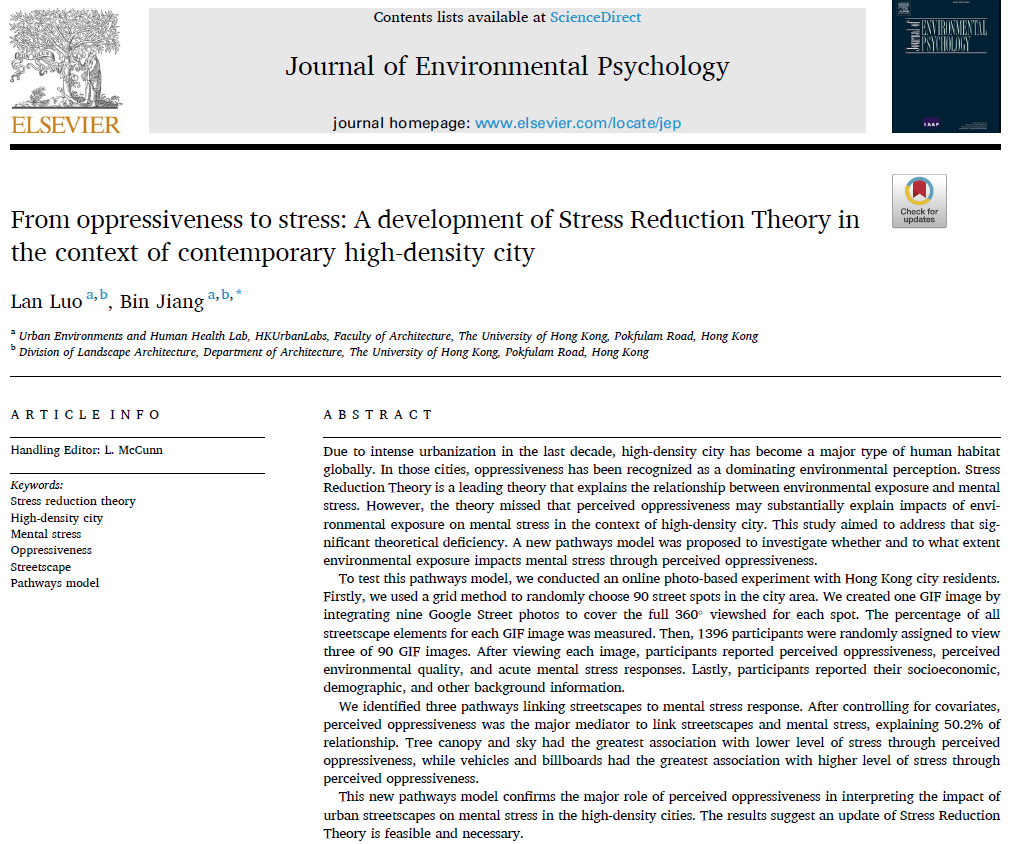Healthy City & Healthy Landscape
“Healthy City, Healthy Landscape” concerns how the built environment and urban landscapes can influence the psychological, physiological, and social health of individuals and lead to more sustainable cities. Through planning and designing physical spaces and landscapes, we can promote healthy and sustainable lifestyles and create clean, safe, pleasant, and equitable environments for people.
Journal Artical

Transformative Power of Urban Green Spaces: Global Insights and Chinese Perspectives
Chinese Landscape Architecture, 2024
This article examines the crucial role of urban green spaces in enhancing human health and wellbeing, integrating global research with a focus on China. The psychological, social, and environmental benefits of green landscapes are discussed, highlighting their importance in landscape architecture, public health, and urban planning. Key research questions regarding equitable access, optimal dose of contact, and the cultural dimensions of green spaces are also addressed. Special attention is given to China’s unique challenges in urbanization and green space distribution, aiming to inform future design strategies and policy developments in landscape architecture. Keywords: landscape architecture; green landscape; health and well-being; global perspective; Chinese environment; research question
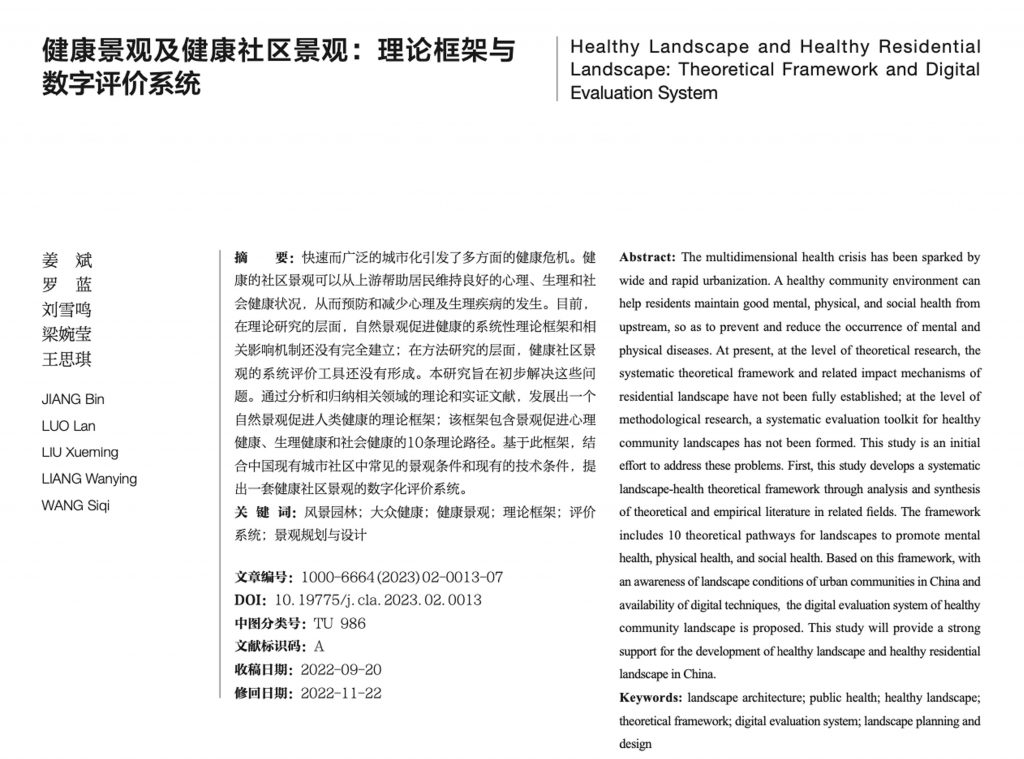
Healthy Landscape and Healthy Residential Landscape: Theoretical Framework and Digital Evaluation System
Chinese Landscape Architecture, 2023
The multidimensional health crisis has been sparked by wide and rapid urbanization. A healthy community environment can help residents maintain good mental, physical, and social health from upstream, so as to prevent and reduce the occurrence of mental and physical diseases. At present, at the level of theoretical research, the systematic theoretical framework and related impact mechanisms of residential landscape have not been fully established; at the level of methodological research, a systematic evaluation toolkit for healthy community landscapes has not been formed. This study is an initial effort to address these problems. First, this study develops a systematic landscape-health theoretical framework through analysis and synthesis of theoretical and empirical literature in related fields. The framework includes 10 theoretical pathways for landscapes to promote mental health, physical health, and social health. Based on this framework, with an awareness of landscape conditions of urban communities in China and availability of digital techniques, the digital evaluation system of healthy community landscape is proposed. This study will provide a strong support for the development of healthy landscape and healthy residential landscape in China.
From Oppressiveness to Stress: A Development of Stress Reduction Theory in the Context of Contemporary High-density City
Journal of environmental psychology, 2022, IF= 7.649
Due to intense urbanization in the last decade, high-density city has become a major type of human habitat globally. In those cities, oppressiveness has been recognized as a dominating environmental perception. Stress Reduction Theory is a leading theory that explains the relationship between environmental exposure and mental stress. However, the theory missed that perceived oppressiveness may substantially explain impacts of environmental exposure on mental stress in the context of high-density city. This study aimed to address that significant theoretical deficiency. A new pathways model was proposed to investigate whether and to what extent environmental exposure impacts mental stress through perceived oppressiveness.
To test this pathways model, we conducted an online photo-based experiment with Hong Kong city residents. Firstly, we used a grid method to randomly choose 90 street spots in the city area. We created one GIF image by integrating nine Google Street photos to cover the full 360° viewshed for each spot. The percentage of all streetscape elements for each GIF image was measured. Then, 1396 participants were randomly assigned to view three of 90 GIF images. After viewing each image, participants reported perceived oppressiveness, perceived environmental quality, and acute mental stress responses. Lastly, participants reported their socioeconomic, demographic, and other background information.
We identified three pathways linking streetscapes to mental stress response. After controlling for covariates, perceived oppressiveness was the major mediator to link streetscapes and mental stress, explaining 50.2% of relationship. Tree canopy and sky had the greatest association with lower level of stress through perceived oppressiveness, while vehicles and billboards had the greatest association with higher level of stress through perceived oppressiveness.
This new pathways model confirms the major role of perceived oppressiveness in interpreting the impact of urban streetscapes on mental stress in the high-density cities. The results suggest an update of Stress Reduction Theory is feasible and necessary.
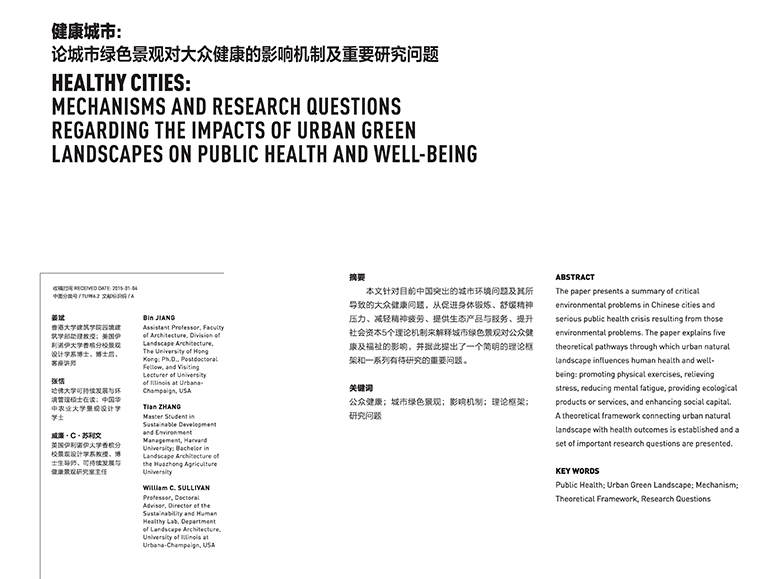
Healthy Cities: Mechanisms and Research Questions Regarding the Impacts of Urban Green Landscapes on Public Health and Well-being
Landscape Architecture Frontiers, 2015
The paper presents a summary of critical environmental problems in Chinese cities and serious public health crisis resulting from those environmental problems. The paper explains five theoretical pathways through which urban natural landscape influences human health and well-being: promoting physical exercises, relieving stress, reducing mental fatigue, providing ecological products or services, and enhancing social capital. A theoretical framework connecting urban natural landscape with health outcomes is established and a set of important research questions are presented. In order to begin to address this problem, this article proposes five mechanisms through which urban green landscape impact human health. For each mechanism, we provide supporting scientific evidence. We draw on research results from multiple disciplines over the past 30 years from a wide variety of disciplines and present a theoretical framework and a series of research questions. We hope this article can provide some basic clues for our city managers, scholars and planners, so that they can carry out research and practices around this important topic.
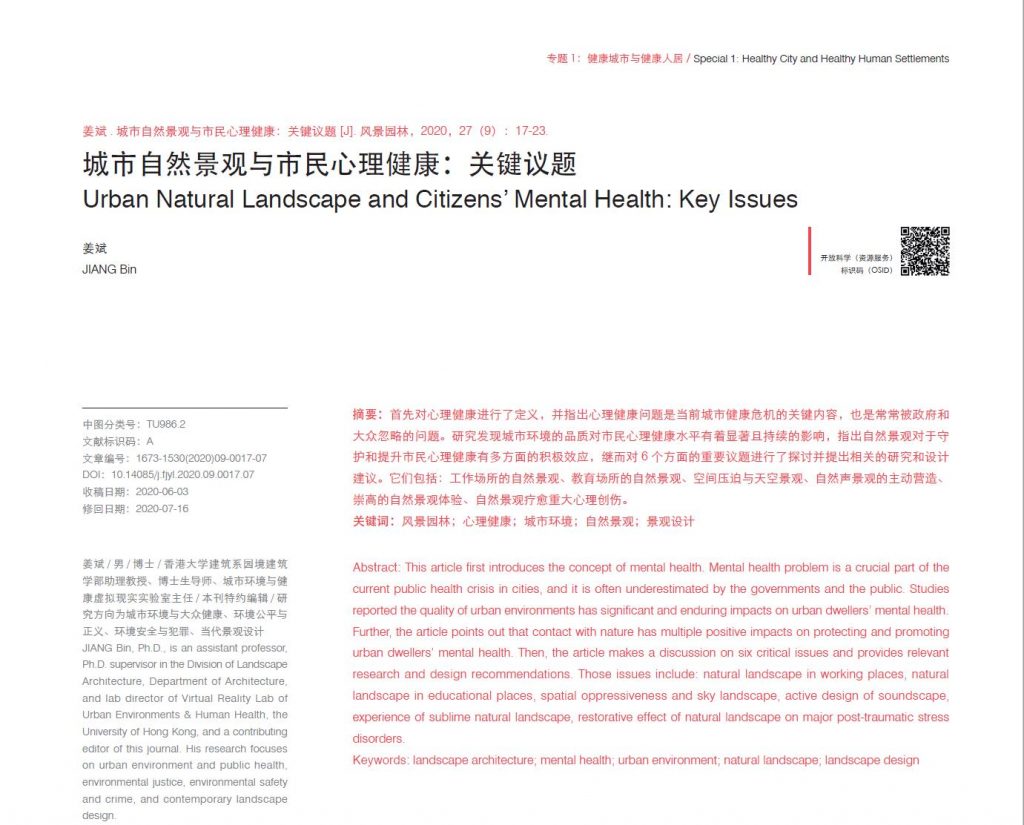
Urban Natural Landscape and Citizens’ Mental Health: Key Issues
Landscape Architecture, 2020
This article first introduces the concept of mental health. Mental health problem is a crucial part of the current public health crisis in cities, and it is often underestimated by the governments and the public. Studies reported the quality of urban environments has significant and enduring impacts on urban dwellers’ mental health. Further, the article points out that contact with nature has multiple positive impacts on protecting and promoting urban dwellers’ mental health. Then, the article makes a discussion on six critical issues and provides relevant research and design recommendations. Those issues include: natural landscape in working places, natural landscape in educational places, spatial oppressiveness and sky landscape, active design of soundscape, experience of sublime natural landscape, restorative effect of natural landscape on major post-traumatic stress disorders.
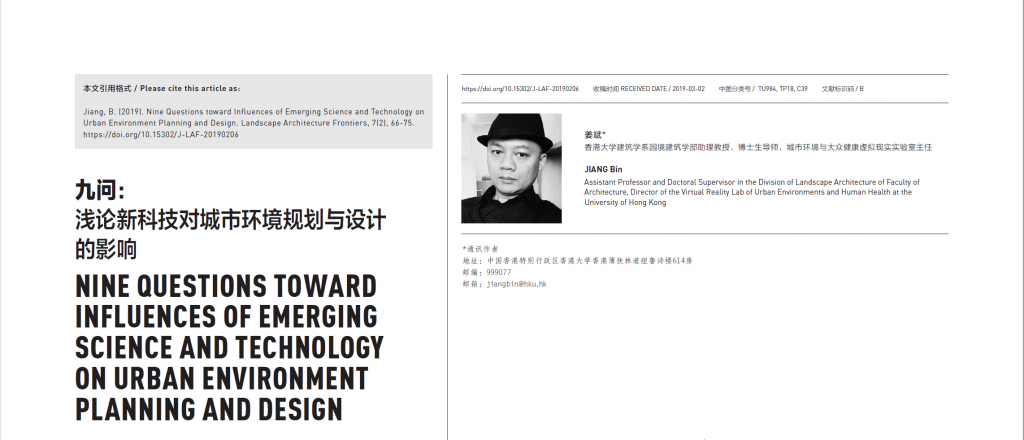
Nine Questions toward Influences of Emerging Science and Technology on Urban Environment Planning and Design
Landscape Architecture Frontiers, 2019
There is no doubt that science and technology have progressed rapidly in the past decade and it is constantly challenging and refreshing people’s understanding of urban environment, human life, and even human nature itself. Meanwhile, its impact on urban environment planning and design should not be ignored and needs to be addressed promptly. The concept of science and technology is self-renewing and has no universal or authoritative definition. In a narrow sense, new science and technology may cover any new materials, technologies, and data invented or discovered by a human; in a broader sense, it might also study new behaviors, emotions, concepts, and philosophy arisen by new materials, technologies, and data. This article explores both positive and negative impacts of science and technology development on urban environment planning and design from nine aspects: image technology, image-tamed design, designers’ dilemma, virtual reality, personal mobile electronic devices, big data, human physical limits, public spaces, and nature. Instead of trying to provide definite answers to these questions, this article seeks to encourage readers’ to understand and think of these topics through a brief discussion.
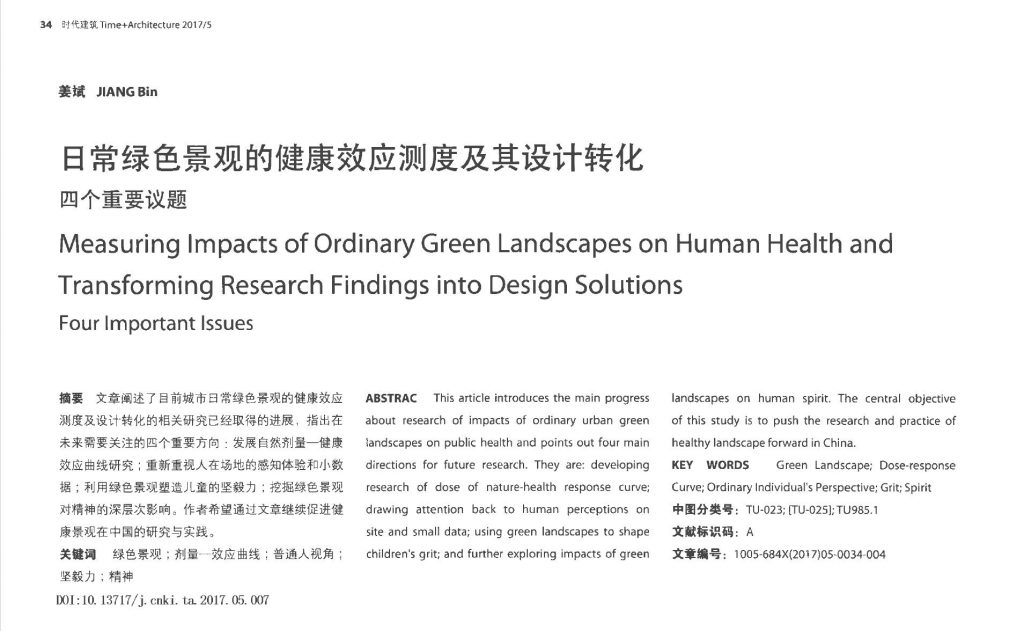
Measuring Impacts of Ordinary Green Landscape on Human Health and Transforming Research Findings into Design Solutions
Time+Architecture, 2017
This article introduces the main progress about research of impacts of ordinary urban green landscapes on public health and points out four main directions for future research. They are: developing research of dose of nature-health response curve; drawing attention back to human perceptions on site and small data; using green landscapes to shape children’s grit; and further exploring impacts of green landscapes on human spirit. The central objective of this study is to push the research and practice of healthy landscape forward in China.
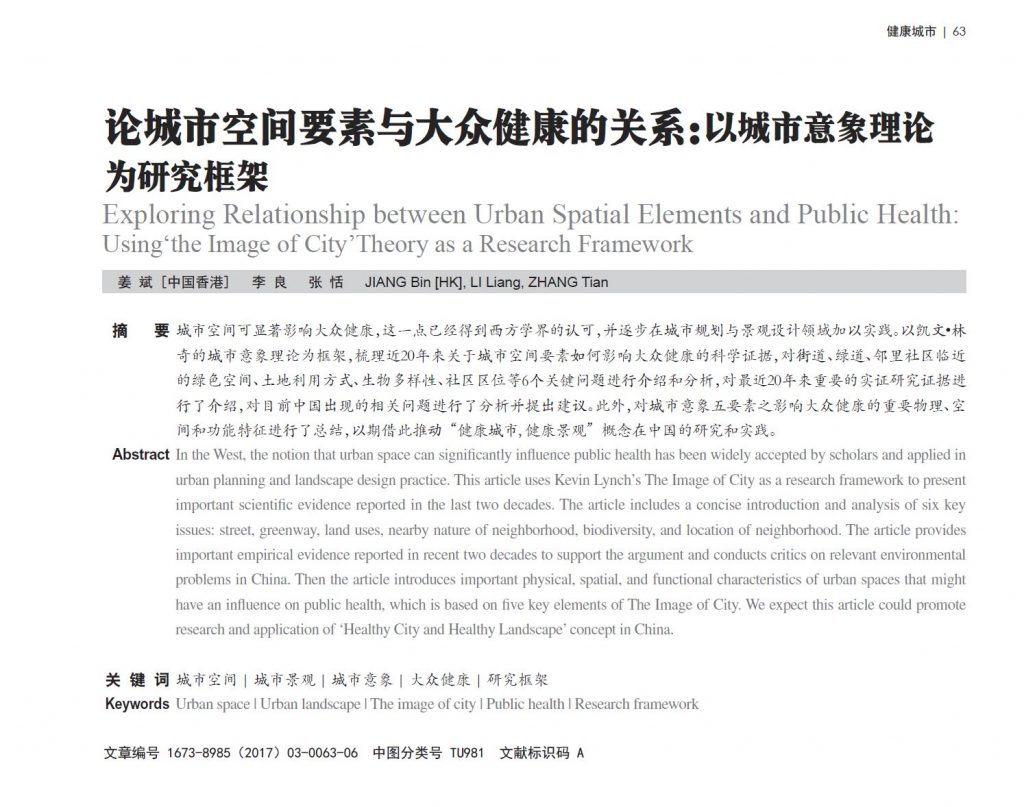
Exploring Relationship between Urban Spatial Elements and Public Health: Using ‘the Image of City’ Theory as a Research Framework
Shanghai Urban Planning Review, 2018
In the West, the notion that urban space can significantly influence public health has been widely accepted by scholars and applied in urban planning and landscape design practice. This article uses Kevin Lynch’s The Image of City as a research framework to present important scientific evidence reported in the last two decades. The article includes a concise introduction and analysis of six key issues: street, greenway, land uses, nearby nature of neighborhood, biodiversity, and location of neighborhood. The article provides important empirical evidence reported in recent two decades to support the argument and conducts critics on relevant environmental problems in China. Then the article introduces important physical, spatial, and functional characteristics of urban spaces that might have an influence on public health, which is based on five key elements of The Image of City. We expect this article could promote research and application of ‘Healthy City and Healthy Landscape’ concept in China.
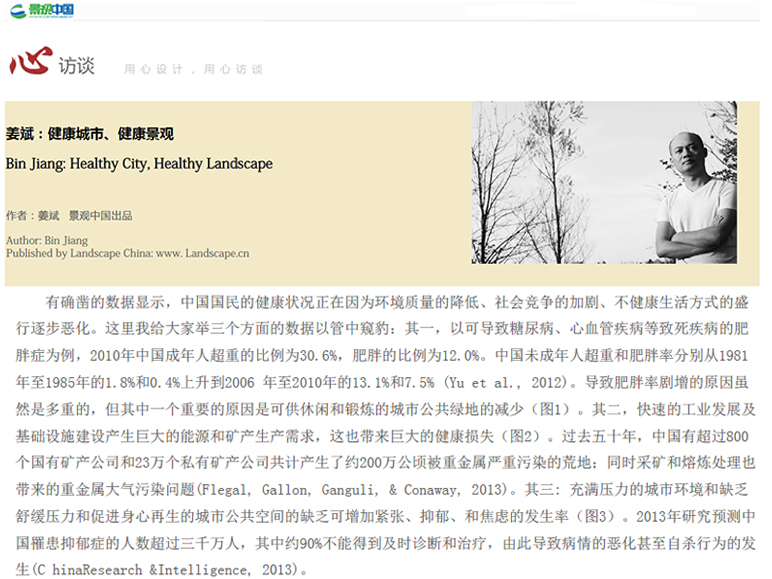
Healthy City, Healthy Landscape
First Published March, 2015
“Healthy City, Healthy Landscape” concerns how the built environment and urban landscapes can influence the psychological, physiological, and social health of individuals and lead to more sustainable cities. Through planning and designing physical spaces and landscapes, we can promote healthy and sustainable lifestyles and create clean, safe, pleasant, and equitable environments for people. Empirical evidence indicates that Chinese citizens’ health is rapidly declining, caused in part by environmental degradation, social competition, and unhealthy lifestyles. After decades of wild urbanization and industrialization in China, the urban environment and the nature that supports this environment have been seriously polluted, dismantled, and damaged. In a country where economic accomplishment is always the priority, policymakers seldom give attention to environmental degradation because this degradation can be difficult to quantify. Unfortunately, Chinese citizens are already paying a high price for this neglect. To contribute to addressing this pressing issue, we conduct quantitative research to promote evidence-based design and provide concrete evidence to support decision-making. We publish books and journal articles to introduce pioneering ideas, research methods, and important research questions. We also give lectures and seminars to encourage more scholars, especially young scholars, to work with us to address these research questions. Informed by our research, we practice design independently and with other distinguished design firms in several cities all over the world.
Report
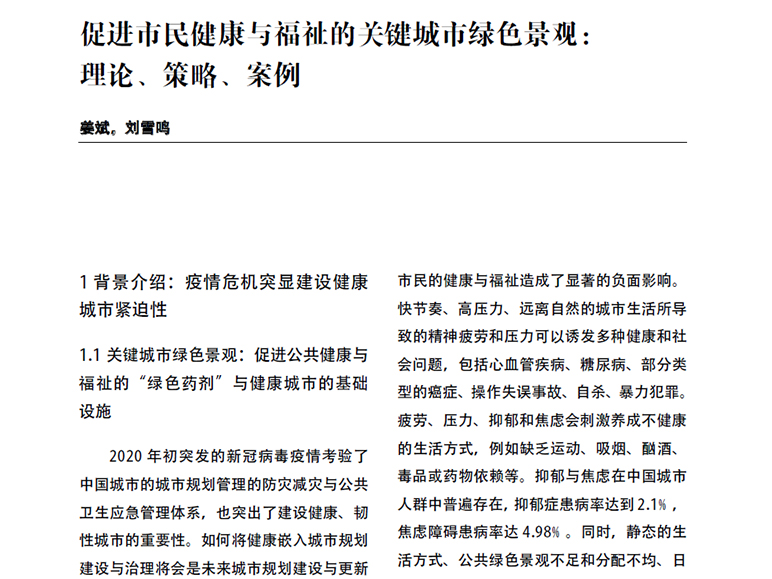
The Key Urban Green Landscape that Promote Public Health and Well-being: Theories, Strategies, and Cases
Consultant Client: Beijing Municipal Commission of Planning and Natural Resources
Key urban green landscapes are the “green dose” that promote public health and well-being and the infrastructure of healthy cities. Although planning and design professionals in China have put forward some strategies, the lack of comprehensive consideration of the health benefits of urban green landscapes can lead to missed opportunities to promote the health of residents. Based on the theoretical framework of five mechanisms through which urban green landscapes impact human health, this study proposes healthy green landscape planning and design strategies for four key green landscape types. The key green landscape space types are work landscape, learning landscape, public living landscape, and community landscape. Urban residents spend most of their living time and working hours in these four types of green landscapes. We hope this article can provide some basic clues for our city managers, scholars and planners, so that they can carry out research and practices around this important topic.

